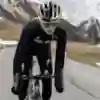Hibernating through the winter isn't an option, so it's time to create a routine to keep yourself moving. Slalom champion Clément Noël shares his winter routine to get the new year off to a flying start. The World Cup winner knows that training off the slopes helps him be successful on them.
Whether you're signing up for competitions or looking to improve your personal fitness, Noël's training will give you the inspiration you need for the winter months.
01
Start with a little mobility
"You can start with 20 minutes of exercise, which looks different depending on your condition," explains Noël. "If you have a bit of back pain, for example, we'll work on that. But if you're feeling good, you can try to improve your flexibility."
Exercises:
- Self-massage: "This has become very fashionable in recent years. The idea is to massage your muscles with a roller, for example, and add more flexibility to your quads or buttocks, for example, if you feel stiff in the morning."
- Stretching: "Classic exercises to relax the hamstrings, psoas, hip flexors and so on. We also try to free up the muscles around the hips because that's an area that gets a lot of use."
- Exercises focusing on the hamstrings and glutes: "Because that's the most important for us. For example, you can lie on your back, elevate one or two feet on a bench or chair and raise your pelvis. Obviously, it's easier to do this with two feet. Alternatively, you can activate your glutes and prepare them to work behind you by tying your ankles or knees together with a rubber band and walking sideways in a crab. Take 10 steps in one direction and 10 steps in the other, and you'll be warmed up!"
02
Power and explosiveness: the art of the twist
"On that point, we've already done most of the work during the summer, and in winter, we're going to focus on working on very high angles, specific to skiing. All this is done in a 40-minute session, sometimes with minimum equipment because we can't always find it in our hotels in winter."
Exercises:
- Sheathing: Sheathing exercises focus on strengthening the connective tissue around your muscles, but in Noël's case: "Twisting the exercises to go for the deep muscles and being steady on your feet when skiing. For example, we can add things specific to our sport, such as trying to balance standing on one leg and a soft base. Alternatively, you can do some classic sheathing by raising your feet or using an unstable roller to make it more difficult."
- Twisted push-ups: "By raising the supports, for example, one arm and one leg when you come up from your push-up. It's not easy in terms of balance, but it helps to strengthen your core while working your arms and pectoral muscles."
- Squats: "You can make them a bit more difficult by holding a stick over your head to strengthen your upper body. Alternatively, if you have the equipment, you can do five reps of front squats, with a 140-150kg barbell in front of you. The idea is to go for squats with fairly low angles and work in a more complete way. Because when you put the bar behind you, the effort is easier and you work mainly on your legs, less on your core."
- Abs: "And more particularly, the 'dragon flag'. You need to be at an advanced level, but it's not dangerous. You put your back on a stable bench and hold it with your hands behind your ears. Then, raise your pelvis and legs as high as possible before lowering yourself back down. But be careful, you have to hold this descent and keep your feet, pelvis and shoulders in good alignment. It's difficult... but it works!"
03
Coordination and speed: cross-disciplinary work
"First of all, you need to know that coordination is worked on through all the other exercises," continues Noël. "That's obviously the case when you're trying to make movements that are as efficient as possible, particularly during support sessions. But there's nothing to stop you from incorporating the examples below into the previous 40-minute session.
Exercises:
- Small jumps: "From one leg to the other, trying to keep the whole chain very taut. We don't want the legs to be too bent, especially as we're entering a ski support."
- Rhythm scale sessions: "We put the feet in and out and add other little exercises, such as knee raises."
- Deviations: "We put our feet on inclined surfaces, alternating between left and right, and making small movements between the supports so that we're not in line all the time!"
04
Aerobics: recovery first
"In winter, the idea is not to develop your cardio. That's done in the summer. So we're going to concentrate more on recovering from our efforts."
Exercises:
- Running or indoor cycling sessions: "But fairly short, between 20 and 35 minutes."
- Intervals: "You can add some during these sessions to put out a few more watts and avoid falling asleep (laughs). So I recommend six minutes of 10/20, i.e. 10 seconds at full throttle, 20 seconds quiet, and so on!"









